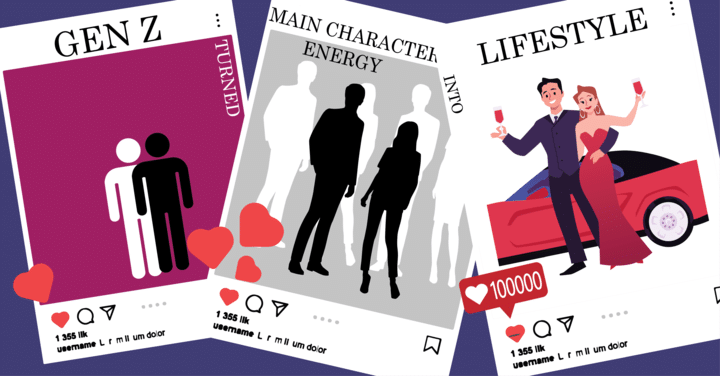What makes a main character? Is it their personality, their appearance, their circumstances? Or perhaps itŌĆÖs simply a foregone conclusion based on the way the media frames them? After all, no one needs to tell you that Meredith Grey or Harry Potter is a main character, you just know it. The thing is, creating characters used to be the business of filmmakers, authors, musicians, etc. Now, with social media, weŌĆÖve taken that ability into our own hands ŌĆō using ourselves as the muse.
A contemporary extension of what Goffman theorized about identity roughly half a century before the rise of social media platforms like Instagram and TikTok, weŌĆÖre now using all available technology to conduct a show online and put ourselves center stage. Most of our social media accounts, whether consciously or not, are more a production, a work of fiction, than a viable representation of who we are. WeŌĆÖre all constantly trying to improve upon this outward image of our identities while probably very often neglecting the inner self.
In recent years, an on-again-off-again trend of having ŌĆ£main character energyŌĆØ has been swirling around social media. Often well-intentioned, it draws on our innate wish to be the main character, to be desirable and powerful and in control, and gives us examples of people who really seem to have achieved that. What it really does, in all the other cases, is perpetuate a phenomenon that keeps everyone viewing their own profile, their own online presence through a hypercritical and completely imagined lens where everyone else is constantly evaluating them.
As Paddy Scannell discussed in Communication as Interaction, ŌĆ£it is one of GoffmanŌĆÖs key insights that the self ŌĆō whatever it might be ŌĆō is not some innate and given thing (it is not an identity), but rather something that is enacted and performed.ŌĆØ Social media allows us to do this in a disconnected and societally acceptable way, as we collectively fabricate and facilitate ŌĆ£main character energyŌĆØ and other trendy, internet versions of our selves.
WeŌĆÖre all, whether we know it or not, living in our perception of the real world and among all of these other people we constantly compare our digital selves to. Just as only you know who you truly are, separate of the photos and posts and captions, your friends, role models, favorite celebrities, etc. are the only ones who know what their lives are really like. Even influencers and accounts that monetize the concept of ŌĆ£pulling back the curtainŌĆØ are still contrived on some level. Modern technology provides us the building blocks to quite literally construct our character, our stages, and therefore manipulate public perception on a scale that even Goffman himself never imagined.
Scannell, P. (2007). Media and Communication. London: Sage. ŌĆśChapter 6: Communication as Interaction: Goffman and Garfinkel, USA, 1950s-1970sŌĆÖ (pp. 145-168)
Image Credit: Trill


This blog post really hits the nail on the head about our current state! It explains the tension between the “main character vibe” everyone chases on social media and their authentic selves so thoroughly I felt more and more relatable as I read on
YouŌĆÖve woven GoffmanŌĆÖs theory with modern social media phenomena so cleverly, getting straight to the core: arenŌĆÖt we all acting as our own screenwriters and lead actors these days? We meticulously craft our “main character personas” in front of the camera, yet gradually forget what our true selves are like. Especially when it talks about the “main character energy” trend it really strikes a chord. We canŌĆÖt help but compare ourselves to othersŌĆÖ glamorous lives, then scrutinize our own profiles with overly critical eyes, always feeling like weŌĆÖre not “main character enough.” In reality, all that pressure is just made up in our heads.
I absolutely love the quoted idea that the self isnŌĆÖt something innate or fixed, but rather “enacted and performed.” That couldnŌĆÖt be more relevant today social media has exactly given us a “performance stage” thatŌĆÖs non-face-to-face and socially acceptable. Everyone jumps on the bandwagon to create all kinds of internet-friendly personas, slowly losing sight of their true selves.
I really liked the way you explained the whole ŌĆ£main characterŌĆØ idea because it made the topic feel very relatable without losing the theoretical side. The way you connected it to Goffman worked really well and it made me think about how much of what we do online is a small performance, even when we feel like we are just being ourselves. Your point about people viewing their own profiles through a very critical lens also felt very true, because it does feel like we are constantly imagining how others see us. I also thought it was interesting how you mentioned that even the posts that claim to be honest or unfiltered are still curated in some way. It made me reflect on how easily social media turns everyday life into something that looks like a character arc. I enjoyed reading this and it gave me a new way to think about how digital spaces shape the way we see ourselves.